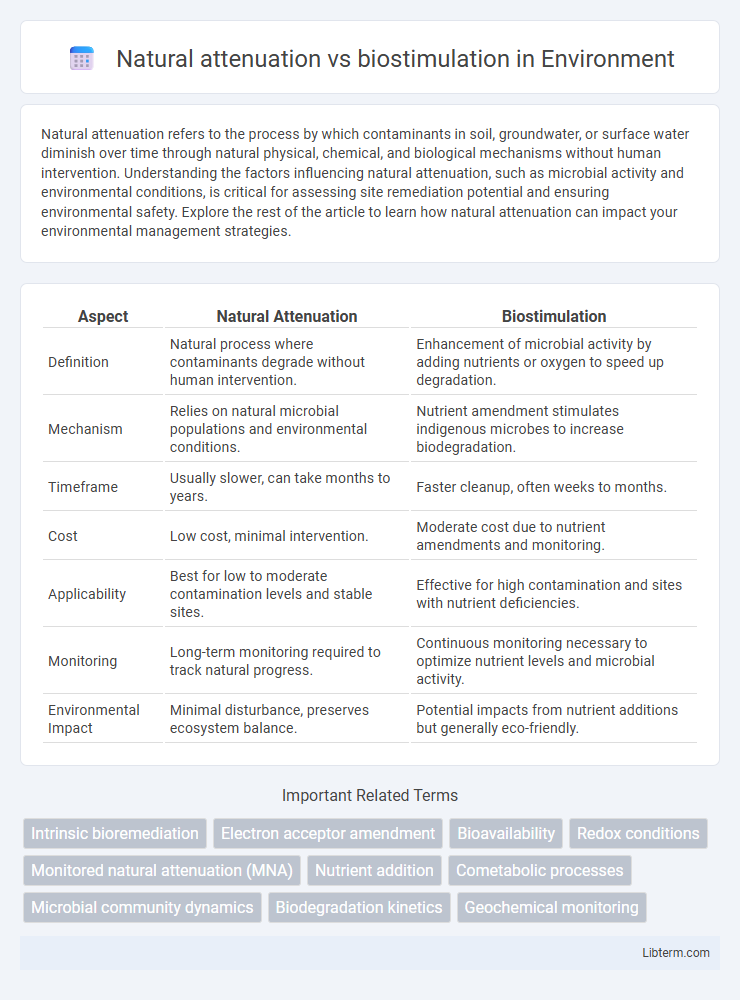Natural attenuation refers to the process by which contaminants in soil, groundwater, or surface water diminish over time through natural physical, chemical, and biological mechanisms without human intervention. Understanding the factors influencing natural attenuation, such as microbial activity and environmental conditions, is critical for assessing site remediation potential and ensuring environmental safety. Explore the rest of the article to learn how natural attenuation can impact your environmental management strategies.
Table of Comparison
| Aspect | Natural Attenuation | Biostimulation |
|---|---|---|
| Definition | Natural process where contaminants degrade without human intervention. | Enhancement of microbial activity by adding nutrients or oxygen to speed up degradation. |
| Mechanism | Relies on natural microbial populations and environmental conditions. | Nutrient amendment stimulates indigenous microbes to increase biodegradation. |
| Timeframe | Usually slower, can take months to years. | Faster cleanup, often weeks to months. |
| Cost | Low cost, minimal intervention. | Moderate cost due to nutrient amendments and monitoring. |
| Applicability | Best for low to moderate contamination levels and stable sites. | Effective for high contamination and sites with nutrient deficiencies. |
| Monitoring | Long-term monitoring required to track natural progress. | Continuous monitoring necessary to optimize nutrient levels and microbial activity. |
| Environmental Impact | Minimal disturbance, preserves ecosystem balance. | Potential impacts from nutrient additions but generally eco-friendly. |
Introduction to Natural Attenuation and Biostimulation
Natural attenuation relies on inherent microbial, chemical, and physical processes to reduce contaminant concentrations in soil and groundwater without human intervention. Biostimulation enhances these natural microbial activities by adding nutrients or electron acceptors, accelerating the degradation of pollutants. Understanding the mechanisms and effectiveness of each approach is critical for selecting the appropriate remediation strategy for contaminated sites.
Defining Natural Attenuation in Environmental Remediation
Natural attenuation in environmental remediation refers to the natural processes such as biodegradation, dispersion, dilution, sorption, and chemical reactions that reduce contaminant concentrations in soil and groundwater without human intervention. It relies on indigenous microbial communities and natural physicochemical mechanisms to degrade or immobilize pollutants over time. This approach is often preferred for sites with low contaminant levels or where active remediation might cause greater disturbance.
Understanding Biostimulation Techniques
Biostimulation techniques enhance natural attenuation by introducing specific nutrients, electron donors, or acceptors to stimulate the indigenous microbial communities responsible for contaminant degradation. This targeted approach accelerates the breakdown of pollutants such as petroleum hydrocarbons, chlorinated solvents, and heavy metals by optimizing environmental conditions like pH, oxygen levels, and nutrient availability. Compared to natural attenuation, biostimulation actively modifies subsurface parameters for faster remediation, improving biodegradation rates and overall site restoration efficiency.
Key Differences between Natural Attenuation and Biostimulation
Natural attenuation relies on natural processes such as dilution, dispersion, and microbial degradation to reduce contaminants without human intervention, while biostimulation actively enhances microbial activity by adding nutrients or electron donors to accelerate pollutant breakdown. Natural attenuation is generally slower and suitable for sites with low contaminant levels, whereas biostimulation is applied when faster remediation is required or when intrinsic microbial activity is insufficient. Biostimulation requires monitoring and management of nutrient levels to avoid secondary pollution, unlike natural attenuation which is largely passive.
Mechanisms of Natural Attenuation
Natural attenuation relies on inherent biological, chemical, and physical processes to reduce contaminant concentrations without external intervention, including biodegradation, dispersion, dilution, sorption, and volatilization. Microbial metabolism plays a critical role by breaking down organic pollutants through aerobic and anaerobic pathways, transforming contaminants into less toxic substances. These natural processes depend on site-specific conditions such as nutrient availability, microbial community structure, and environmental parameters like pH and redox potential.
Methods and Approaches in Biostimulation
Biostimulation enhances natural attenuation by actively adding nutrients, electron donors, or acceptors to contaminated sites, thereby accelerating microbial degradation processes. Techniques in biostimulation include nutrient amendment, oxygen replenishment, and adjusting environmental conditions such as pH and temperature to optimize microbial activity. Unlike natural attenuation, which relies on indigenous microbial processes without intervention, biostimulation involves controlled manipulation to significantly improve contaminant breakdown rates in soil and groundwater.
Factors Influencing the Effectiveness of Both Strategies
Natural attenuation effectiveness is influenced by factors such as the presence of native microbial populations, contaminant concentration, nutrient availability, and environmental conditions including temperature, pH, and redox potential. Biostimulation effectiveness depends on the successful amendment of limiting nutrients (e.g., nitrogen, phosphorus), electron donors or acceptors, and maintaining optimal conditions for microbial activity. Both strategies require thorough site characterization to evaluate hydrogeology, contaminant distribution, and potential toxicities that can inhibit biodegradation processes.
Advantages and Limitations of Natural Attenuation
Natural attenuation relies on inherent microbial, chemical, and physical processes to reduce contaminants without external intervention, offering cost-effectiveness and minimal site disturbance. Its limitation lies in slower remediation rates and uncertainty in contaminant reduction, making it less suitable for sites with high contamination levels or requiring rapid cleanup. Regulatory acceptance and thorough site characterization are critical to ensure natural attenuation meets cleanup goals effectively.
Benefits and Challenges of Biostimulation
Biostimulation enhances the natural attenuation process by adding nutrients or electron acceptors to accelerate microbial degradation of contaminants, improving remediation efficiency in polluted sites. Benefits of biostimulation include faster contaminant breakdown, tailored treatment for specific pollutants, and improved control over environmental conditions to optimize microbial activity. Challenges involve potential nutrient imbalances, the risk of promoting undesirable microbial populations, and the need for careful monitoring to avoid unintended environmental impacts such as secondary contamination or oxygen depletion.
Choosing the Right Remediation Strategy: Decision Criteria
Choosing the right remediation strategy involves evaluating site-specific conditions such as contaminant type, concentration, and soil characteristics to determine whether natural attenuation or biostimulation is more effective. Natural attenuation relies on indigenous microbial activity and favorable environmental factors for contaminant degradation, making it suitable for low-risk sites with slow contaminant breakdown. Biostimulation enhances microbial degradation by adding nutrients or electron donors, accelerating contaminant removal in sites with limiting conditions or higher pollution levels.
Natural attenuation Infographic

 libterm.com
libterm.com